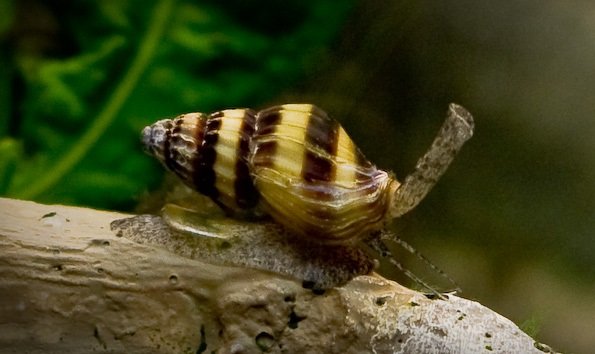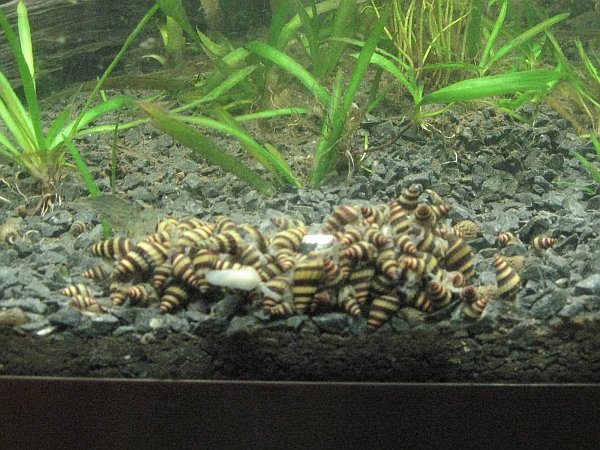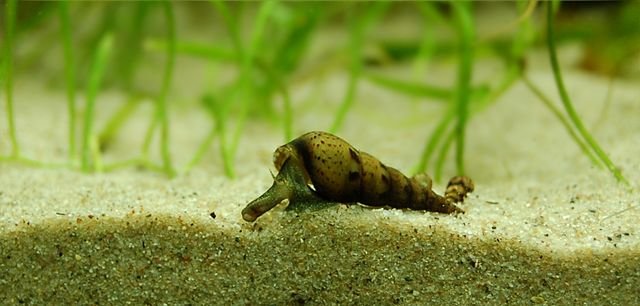
The Assassin Snail (Anentome helena) is a natural and efficient solution for controlling snail pests in aquariums, earning them the nickname “natural pest controllers.” Their predatory nature and striking appearance make them a favorite among aquarists.
This article covers everything you need to know about the assassin snail (Anentome helena): its anatomy, behavior, care, compatibility, and the benefits it offers for a healthy aquatic ecosystem.
Features of the Assassin Snail
- 1 Features of the Assassin Snail
- 2 Natural Habitat of the Bumblebee snail (Anentome helena)
- 3 How Does the Assassin Snail Feed?
- 4 What Is the Ideal Number of Assassin Snails for an Aquarium?
- 5 How to care for Assassin Snails?
- 6 Reproduction and Life Cycle of Assassin Snails
- 7 Compatibility of Assassin Snails with Other Species
- 8 Benefits of Assassin Snails in Pest Control
- 9 Conclusion
- 10 References
- 11 Entradas relacionadas:
Taxonomy of Assassin Snails
The taxonomy of the assassin snail, Anentome helena, is as follows:
- Kingdom: Animalia
- Phylum: Mollusca
- Class: Gastropoda
- Subclass: Caenogastropoda
- Order: Neogastropoda
- Family: Nassariidae
- Genus: Anentome
- Species: Anentome helena
- Synonym: Clea helena
- Common Names in Spanish: Caracol asesino
- Common Names in English: Assassin snail, Bumblebee snail, Snail Killer, Killer Snail, Snail-eating snail
Strong et al., (2017) proposed separating the genus Clea into two distinct genera: Clea for the type species Clea nigricans and its relatives, and Anentome for Clea helena and its relatives. This reclassification was based on differences in the shell, operculum, and radula, as well as molecular phylogenetic data.
Physical Characteristics of the Assassin Snail
The assassin snail (Anentome helena) exhibits the following physical features:
- Size: Bumblebee snails typically grow to between 18 and 32 mm (0.7–1.25 inches), although they may be smaller in aquariums due to food availability, which is a key factor influencing their size.
- Shell Shape: The shell is conical and spiral-shaped.
- Shell Coloration: The shell has dark brown and yellow-bronze bands, earning it the common name “bumblebee snail.” Some specimens may have completely brown shells without bands. The shell has a striated texture.
- Operculum: The snail has an operculum, a trapdoor-like structure that seals the shell opening. The operculum should be visible near the top of the foot, close to the rear.
- Body and Foot: The body and foot are light cream-colored with darker spots scattered across them.
- Siphon: The assassin snail has a siphon used to draw water over its gills and detect food. The siphon can be seen extended as the snail moves.
- Proboscis: It has a fully developed proboscis, which it uses to immobilize prey before consuming it.
- Tentacles: The snail has two tentacles, each with an eye near its base.
These features make Anentome helena easily recognizable and distinguishable from other snail species.
How Long Do Assassin Snails Live?
In optimal aquarium conditions, assassin snails can live for up to 2 or 3 years. However, their lifespan can be significantly affected by factors such as water quality, diet, and stressors.
Natural Habitat of the Bumblebee snail (Anentome helena)
The assassin snail (Anentome helena) is native to Southeast Asia, found in countries such as Malaysia, Thailand, and the Indonesian island of Sumatra, specifically in Lake Toba. It has also been reported in Cambodia, Vietnam, and Laos.
Stay Always Informed
Join our communities to instantly receive the most important news, reports, and analysis from the aquaculture industry.
Anentome helena inhabits streams and creeks with muddy, sandy, or silty bottoms. They spend much of their time buried in the substrate, emerging to hunt or feed. These snails prefer warm, alkaline waters with moderate to high hardness levels.
It is important to note that, while their natural distribution is in Southeast Asia, Anentome helena has been introduced to other regions due to its popularity in the aquarium trade. The presence of these snails in non-native habitats can pose risks to local fauna.
How Does the Assassin Snail Feed?
Assassin snails are generalist carnivores because they feed on various types of prey (Berkhout and Morozov, 2022). To capture their prey, they use an extended proboscis equipped with a tooth-like structure (radula) that pierces the shell of the target snail (Paul et al., 2021). They inject digestive enzymes to liquefy the soft tissue and then consume it. Their diet includes:
- Other snails: Bumblebee snails are predators of other gastropods. They are called “assassin snails” because of their habit of eating other snails. They are known for controlling populations of pest snails in aquariums, such as Malaysian trumpet snails, ramshorn snails, and bladder snails.
- Assassin snails often bury themselves in the substrate to ambush their prey.
- They attack other snails by immobilizing them with their foot and consuming them through the shell’s opening.
- Snails without an operculum, like ramshorn snails, are particularly vulnerable to their attacks.
- They can also consume the eggs of soft-shelled snails but not those of nerite snails.
If sufficient prey is unavailable, they may accept high-protein commercial foods, such as fish flakes, pellets, frozen bloodworms, bottom-feeder tablets, and gel foods. Mineral-enriched foods can also be offered to support shell growth.
Bumblebee snails detect their prey using their siphon. This organ allows them to draw water over their gills and “smell” their surroundings. When they sense food, they emerge from the substrate to hunt.
Additionally, assassin snails exhibit selective feeding behavior. While they can be considered generalist predators at the population level, individual snails often show preferences for specific types of prey. For example, experimental studies have shown that assassin snails prefer ramshorn snails over other prey types, regardless of their relative abundance. This individual preference may be influenced by prior experience or learned handling strategies.

What Is the Ideal Number of Assassin Snails for an Aquarium?
The recommended number of assassin snails (Anentome helena) to control pest infestations in an aquarium varies depending on several factors, including the tank size, the severity of the pest snail infestation, and the specific species of pest snails present. Here are the recommendations based on various sources:
- Infestation Assessment: Before introducing assassin snails, it is essential to evaluate the magnitude of the pest snail infestation in your aquarium. A small infestation can be managed with a few assassin snails, while a severe infestation will require a larger number.
- Tank Size: The number of assassin snails should be adjusted according to the size of the aquarium:
- Small aquariums (10-20 gallons): Start with 2-3 assassin snails.
- Larger aquariums: For larger tanks, 5-8 or more assassin snails may be needed, especially in cases of severe infestations.
- Water Temperature: Dickey et al., (2023) found that A. helena is an effective predator, but its feeding efficiency is influenced by temperature. While the species can survive at lower temperatures (18°C), its reduced feeding rate limits its predatory impact.
- Patience: It’s important to be patient as assassin snails need time to adapt and begin hunting. Reducing pest snail populations takes time.
- Regular Monitoring: Regularly monitor the pest snail population and the effectiveness of assassin snails. A declining pest snail population indicates success. If no significant reduction is observed, consider increasing the number of assassin snails.
- Pest Snail Species: Assassin snails are effective at controlling populations of pest snails such as pond snails, Malaysian trumpet snails, ramshorn snails, and bladder snails. They can eliminate pest snails equal to or smaller in size than themselves.
- Larger Snails: While assassin snails generally do not harm larger snails like mystery snails, nerite snails, or rabbit snails, large groups of assassin snails could attack and kill bigger snails.
- Managing Assassin Snail Populations: If the population of assassin snails grows too large, you can:
- Reduce Feeding: Assassin snail reproduction is tied to food availability, so reducing the amount of food in the tank can regulate their growth.
- Manual Removal: Remove excess assassin snails manually from the aquarium.
- Adjust Tank Conditions: Slightly modifying temperature or water parameters can make breeding conditions less favorable.
- Hunting Behavior: Assassin snails are ambush predators that bury themselves in the substrate and wait for their prey to pass nearby. They use their siphon to detect prey and their proboscis to immobilize and consume it.
Karmakar et al., (2022) studied the predation impact of A. helena on two freshwater snails, Racesina luteola and Physella acuta, in a laboratory setting. They concluded that the predation rate of A. helena was influenced by the density of both predators and prey. Variations in P. acuta density affected predation rates, whereas changes in R. luteola density did not significantly impact them.
Summary: To control pest snails, it is recommended to start with a small group of Bumblebee snails, monitor their effectiveness, and adjust the number as needed. The ideal number depends on tank size and infestation severity, but patience and careful observation are key.
How to care for Assassin Snails?
A 10-gallon tank is sufficient for a small group of assassin snails. They prefer sandy or fine substrates that facilitate movement and allow them to partially bury themselves. These snails thrive in water with a pH of 6.5 to 7.5, temperatures between 20°C and 28°C (68-82°F), and moderate hardness (Table 01). Maintaining stable water quality is essential for their health.
Table 01. Parameters for the care of the assassin snail (Anentome helena) in aquariums.
| Parameter | Range |
| Tank Size | 10 gallons |
| Water Temperature | 21–27 °C (70–80 °F) |
| Water pH | 6.5 to 7.5, ideal 7.0 |
| Water Hardness (GH) | 6-20 dGH |
- Water changes: Regular water changes (20-25% weekly) are essential to maintain good water quality and prevent the buildup of harmful toxins.
- Filtration: A high-quality filter is necessary to remove waste and ensure proper water circulation.
Renk et al., (2024) reported that the assassin snail Anentome helena is highly sensitive to salinity changes, limiting its invasion potential compared to other common snail species in the pet trade, such as Melanoides tuberculata and Tarebia granifera.
Reproduction and Life Cycle of Assassin Snails
Mating and Egg Laying Process
Coelho et al., (2013) and Monks (2016) report that Clea helena (Anentome helena) is a dioecious species, meaning males and females are separate individuals; however, they do not exhibit apparent sexual dimorphism. These snails reproduce in laboratory conditions year-round, though their fertility rate is low, laying only 1 to 4 eggs per clutch. Copulation lasts approximately 3 hours and 40 minutes.
Egg capsules attach to various solid surfaces in the aquarium. Common locations include plants, driftwood, rocks, decorations, and sometimes even the aquarium glass.
Incubation
Fertile eggs typically hatch within a few weeks, usually between 3 to 8 weeks. The incubation period may vary due to factors such as temperature and water mineral content.
Juvenile Rearing
After hatching, assassin snail juveniles (3.1 ± 0.3 mm shell length) tend to bury themselves in the substrate and rarely emerge until they reach maturity. This maturation process usually takes around six months. During this time, the juveniles remain in the substrate, growing before becoming more active and visible.
According to Coelho et al. (2013), population density also influences juvenile growth. In the first month, individuals raised at a density of 5 snails/L experienced significantly faster growth rates than those raised at 20 snails/L.
Compatibility of Assassin Snails with Other Species
Raising assassin snails (Anentome helena) in an aquarium is compatible with various species, though certain precautions should be taken due to their predatory nature.
Fish:
Generally, assassin snails are compatible with most aquarium fish, although they may consume fish eggs. Therefore, if keeping fish that lay eggs on the aquarium substrate or plants, the presence of A. helena might not be ideal.
Crustaceans:
Assassin snails may also prey on crustaceans (e.g., shrimp). This should be considered if keeping shrimp or other crustaceans in the aquarium. With ornamental shrimp such as Amano or Cherry shrimp, there are usually no issues; assassin snails focus exclusively on pest snails.
Plants:
Assassin snails do not typically damage plants, making them compatible with planted aquariums.
In summary, while assassin snails are excellent for controlling pest snail populations, it is essential to consider their carnivorous diet when choosing compatible species for the aquarium. They are not selective and may consume various prey, including other snails, fish eggs, and shrimp.
Benefits of Assassin Snails in Pest Control
Assassin snails (Anentome helena) are used in aquariums due to their carnivorous nature, which allows them to control populations of other snails that become pests. Unlike other methods, such as using chemicals, assassin snails offer a more natural biological control method.
Some benefits of using A. helena instead of other methods include:
- Specific pest control: A. helena primarily feeds on other snails, including species like Helisoma sp., Melanoides sp., Physa sp., and Planorbella sp., which often become pests in aquariums.
- Natural method: As a natural predator of snails, assassin snails do not introduce chemicals into the aquarium that could harm other organisms.
- Reduced dependence on chemical methods: Using A. helena can reduce or eliminate the need for chemical treatments to control pest snails.
- Aesthetic benefit: Assassin snails are visually appealing due to their distinctive shells, making them an interesting addition to the aquarium.
- Predator and scavenger: A. helena not only preys on other snails but also acts as a scavenger, consuming organic debris and fish eggs, contributing to a cleaner aquarium.
- Adaptability: Assassin snails are well-adapted to captive conditions.
It is important to note that while A. helena can benefit pest snail control, they are not selective and may also feed on fish eggs and other invertebrates. Additionally, if A. helena is introduced into natural ecosystems, it could threaten native snail populations.
Myths and Realities about Assassin Snails
Myth: They exclusively feed on snails.
Reality: They are opportunistic and will accept other types of food.
Myth: They are aggressive toward all invertebrates.
Reality: They generally ignore species that are not pest snails.
Conclusion
Assassin snails (Anentome helena) are an indispensable tool for any aquarist dealing with pest snail issues. Their efficiency, ease of care, and contribution to a balanced ecosystem make them an excellent addition to any freshwater tank.
However, introducing assassin snails into non-native freshwater habitats could negatively impact native snail communities, requiring strict regulations regarding their uncontrolled sale in pet stores (Paul et al., 2021). Additionally, Stanicka et al., (2022) found evidence of digenean larvae (trematodes) in A. helena specimens imported to the European Union for the pet trade, highlighting the risk of ornamental snails carrying parasites and posing a threat to the environment and public health.
With the provided information and tips, you are now ready to make the most of these fascinating predators. Embrace a natural approach to maintaining a healthy, pest-free aquarium!
References
Berkhout, B. W., & Morozov, A. (2022). Assassin snails (Anentome helena) as a biological model for exploring the effects of individual specialisation within generalist predators. PLOS ONE, 17(3), e0264996. https://doi.org/10.1371/journal.pone.0264996
Coelho AR, Dinis MT, Reis J (2013) Effect of Diet and Stocking Densities on Life History Traits of Clea helena (Philippi 1847) Reared in Captivity. J Aquac Res Development 4: 187 doi:10.4172/2155-9546.1000187
Dickey JWE, Jeschke JM, Steffen GT, Kazanaviciute E, Brennan RS, Briski E (2023) Current temperatures limit the potential impact of a commonly traded predatory gastropod. Aquatic Invasions 18(2): 247–261. https://doi.org/10.3391/ai.2023.18.2.103208
Karmakar, R., P. Paul and G. Aditya: Predation and prey preference of the exotic snail Anentome helena on two freshwater snails: implications for species invasion. J. Environ. Biol., 43, 293-298 (2022).
Monks Neale. 2016. Clea helena (assassin snail). CABI Digital Library. https://doi.org/10.1079/cabicompendium.108187
Paul, P., Paul, K., Karmakar, R., Shee, A., Kumar, D., & Aditya, G. (2021). The Exotic Gastropod Clea helena (von dem Busch, 1847) as a Predator of Freshwater Gastropods: A Threat to Native Biota in India? Limnological Review, 21(1), 55-62. https://doi.org/10.2478/limre-2021-0005
Renk, E., Dickey, J. W., Cuthbert, R. N., Kazanaviciute, E., & Briski, E. (2024). Differential survival and feeding rates of three commonly traded gastropods across salinities. NeoBiota, 94, 79-100.
Stanicka, A., Maciaszek, R., Cichy, A., Templin, J., Swiderek, W., Zbikowska, E., & Labecka, A. M. (2022). Unwanted ‘hitchhikers’ of ornamental snails: a case report of digeneans transported via the international pet trade. The European Zoological Journal, 89(1), 601–607. https://doi.org/10.1080/24750263.2022.2065039
Strong EE, Galindo LA, Kantor YI. 2017. Quid est Clea helena? Evidence for a previously unrecognized radiation of assassin snails (Gastropoda: Buccinoidea: Nassariidae) PeerJ 5:e3638 https://doi.org/10.7717/peerj.3638
Editor at the digital magazine AquaHoy. He holds a degree in Aquaculture Biology from the National University of Santa (UNS) and a Master’s degree in Science and Innovation Management from the Polytechnic University of Valencia, with postgraduate diplomas in Business Innovation and Innovation Management. He possesses extensive experience in the aquaculture and fisheries sector, having led the Fisheries Innovation Unit of the National Program for Innovation in Fisheries and Aquaculture (PNIPA). He has served as a senior consultant in technology watch, an innovation project formulator and advisor, and a lecturer at UNS. He is a member of the Peruvian College of Biologists and was recognized by the World Aquaculture Society (WAS) in 2016 for his contribution to aquaculture.




